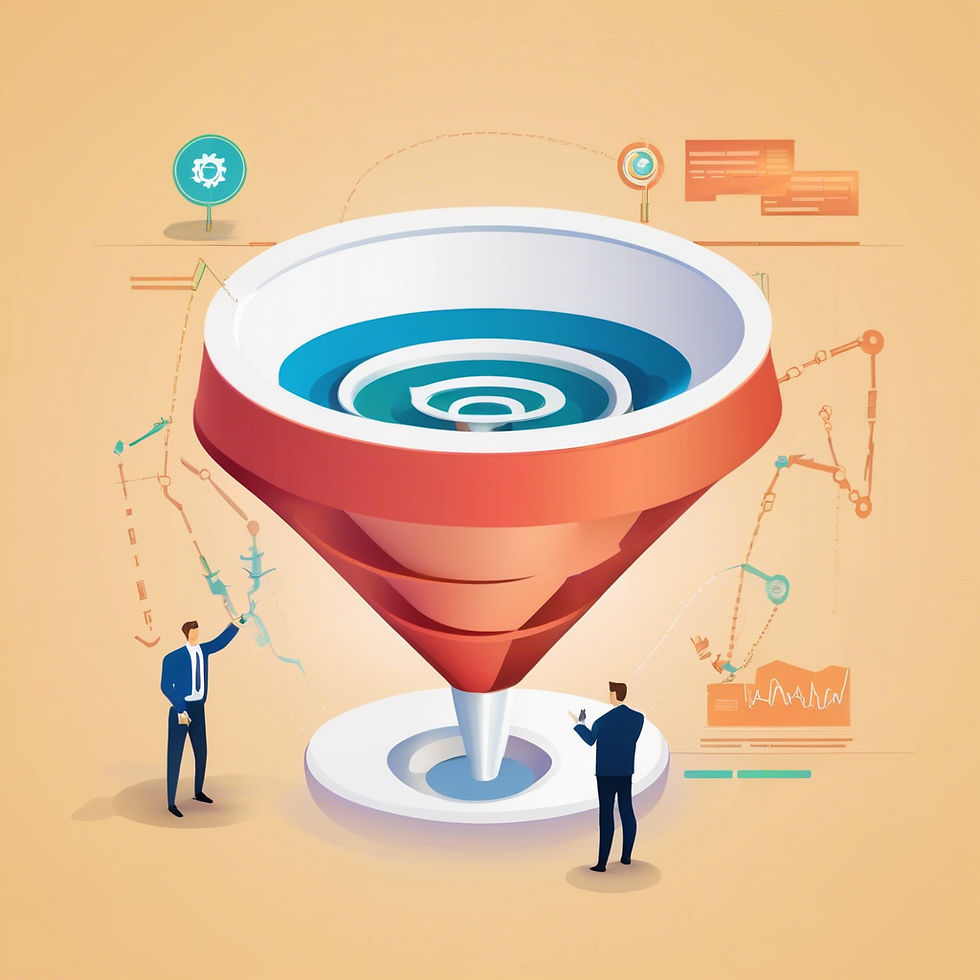How to Build a Sales Funnel That Converts in 2025 in Manufacturing
- Eldon Riley

- Aug 13
- 10 min read
Building a sales funnel in manufacturing is crucial for success. In 2025, it will be even more vital to have a converting funnel.
Manufacturing companies face unique challenges in sales. A well-designed sales funnel can streamline your process and boost conversions. This guide will help you understand the steps to create a sales funnel tailored for the manufacturing industry. We'll explore the best practices, tools, and strategies you need to succeed in 2025.
By the end, you'll know how to attract leads, nurture them, and turn them into loyal customers. Let's dive into the essentials of building a successful sales funnel for manufacturing in 2025.

Introduction To Sales Funnels
The digital age has transformed how businesses operate. For manufacturing companies, understanding and implementing a sales funnel is vital for growth. But what exactly is a sales funnel? And how does it apply to manufacturing in 2025?
Purpose Of A Sales Funnel
A sales funnel guides potential customers through their buying journey. It starts with awareness and ends with a purchase. This process helps businesses manage and optimize their sales efforts.
By segmenting this journey into stages, companies can identify where prospects drop off. This insight allows for targeted improvements. In manufacturing, this funnel helps in understanding client needs. It also assists in providing solutions at each stage.
Importance In Manufacturing
Manufacturing businesses often deal with complex sales cycles. High-value products require careful consideration from buyers. A well-designed sales funnel simplifies this process. It ensures that prospects receive the right information at the right time.
This approach builds trust and nurtures leads effectively. The funnel also helps in tracking customer interactions. By analyzing these interactions, companies can refine their strategies. This leads to higher conversion rates and better customer satisfaction.
Identifying Target Audience
Identifying the target audience is crucial in building an effective sales funnel for manufacturing in 2025. Understand their needs and preferences to tailor your approach. This ensures higher engagement and conversion rates.
In 2025, building a sales funnel that converts in the manufacturing sector starts with identifying your target audience. This crucial step ensures that your marketing efforts are not wasted on people who are unlikely to buy your products. Knowing your ideal customers allows you to tailor your strategies to meet their specific needs and preferences.
Defining Ideal Customer
First, ask yourself, who benefits the most from your products? Your ideal customer should have a genuine need for what you are offering. They should also have the budget to afford it and the authority to make purchasing decisions. Think about your past clients. Which ones were the most satisfied and profitable?
Analyze their demographics, industries, and company sizes. Create a detailed profile of your ideal customer. Include information such as age, location, job title, and pain points. This helps you visualize who you are targeting and tailor your messaging accordingly.
Market Research Techniques
Market research is essential to validate your assumptions about your target audience. Use surveys and questionnaires to gather information directly from potential customers. Online tools like Google Analytics can help you understand who is visiting your website. Look at metrics such as age, gender, and interests.
Social media platforms offer insights into the demographics and behaviors of your followers. Use these insights to refine your customer profiles. Attending industry trade shows and events can also provide valuable information. Engage in conversations with attendees to understand their challenges and needs.
Lastly, don't underestimate the power of competitor analysis. Look at who your competitors are targeting and see if there are any gaps you can fill. Identifying your target audience is a continuous process. As the market evolves, so should your understanding of who your ideal customers are. By staying attuned to their needs, you can build a sales funnel that effectively converts in the manufacturing sector in 2025.

Creating Awareness
Creating awareness is the first crucial step in building a sales funnel that converts, especially in the competitive manufacturing industry. In 2025, companies must use innovative strategies to capture attention and educate potential customers about their products. This section will cover effective methods for creating awareness, focusing on content marketing strategies and social media campaigns.
Content Marketing Strategies
Content marketing is a powerful tool to create awareness in the manufacturing sector. By sharing valuable information, you can establish your brand as a thought leader. Start by identifying the key challenges your target audience faces. Provide solutions through blog posts, white papers, and case studies. This approach not only educates your audience but also builds trust.
Consider creating video tutorials and product demos. These can be highly effective in explaining complex products and processes. A well-crafted video can capture attention quickly and is easily shareable. Don’t forget to optimize your content for search engines. Use relevant keywords to ensure your content is discoverable. This can significantly increase your reach and attract more potential customers.
Social Media Campaigns
Social media platforms are essential for creating awareness. They allow you to reach a large audience quickly and engage with them directly.
Start by choosing the right platforms. LinkedIn and Twitter are great for B2B marketing, while Facebook and Instagram can also be useful depending on your audience. Tailor your content to fit each platform's style and user behavior.
Run targeted ad campaigns to reach specific demographics. Use compelling visuals and clear calls to action to grab attention. Monitor the performance of your ads and adjust them as needed. Engage with your audience by responding to comments and messages promptly. This shows that you value their input and are ready to help. Regular interaction can turn casual followers into interested leads.
What creative strategies have you found effective in building awareness in your industry? Share your thoughts and experiences in the comments below. Let’s learn from each other and build more effective sales funnels together!
Generating Leads
Building an effective sales funnel in manufacturing for 2025 involves attracting potential customers, nurturing leads, and converting them into buyers. Focus on understanding their needs and providing valuable content at each stage. Make sure to use data and automation tools to streamline the process.
Generating leads is the first and most important step in building a sales funnel. In the manufacturing industry, this process involves attracting potential customers who show interest in your products. To achieve this, you must use effective strategies. These strategies will help you capture the attention of your target audience.
Lead Magnets And Offers
Lead magnets are valuable resources you offer to potential customers. These can be eBooks, whitepapers, or free samples. The goal is to exchange these resources for contact information. This information helps you to follow up with the leads. Offers can also include discounts or special deals. These incentives encourage prospects to take the next step in the sales process.
Effective Landing Pages
Landing pages play a crucial role in generating leads. These pages should be clear and focused. They must highlight the benefits of your lead magnet or offer. Use a simple design and strong call-to-action (CTA) buttons.
This will guide visitors on what to do next. Ensure the landing page loads quickly. A slow page can drive potential leads away. Finally, use engaging and straightforward language. This will help keep visitors interested and increase your chances of conversion.

Nurturing Prospects
Creating an effective sales funnel for manufacturing in 2025 involves understanding your prospects' needs and guiding them through each stage. Engage potential clients with personalized content and streamlined processes to enhance conversion rates.
Nurturing prospects is a critical part of building a sales funnel that converts in manufacturing. In 2025, the key to success lies in how you engage and build relationships with potential customers. Your approach to nurturing prospects can make or break your sales funnel. Let's dive into some effective strategies that you can use.
Email Marketing Automation
Email marketing automation can be a game-changer. It allows you to send timely and relevant messages to prospects without manual effort. Imagine sending a follow-up email right after a prospect downloads your product brochure. This can keep your brand top of mind. Automation tools can also segment your audience based on their behavior.
You can tailor your messages to different segments. This ensures your emails are more relevant and engaging. I remember setting up an automated email sequence for a client in the manufacturing sector. The open rates improved by 30% because the content was timely and personalized. Have you tried automating your emails yet?
Personalized Follow-ups
Personalized follow-ups can significantly improve your conversion rates. When you address a prospect by their first name and refer to their specific needs, it shows that you care. This personal touch can differentiate you from competitors. Use data to personalize your follow-ups. If a prospect visited your website and checked out a particular product, mention it in your follow-up email. This shows that you are paying attention. I once had a client who was skeptical about personalized follow-ups. After trying it for a month, they saw a 25% increase in response rates. Are you leveraging personalized follow-ups in your sales funnel? Nurturing prospects effectively requires a blend of automation and personalization. By using email marketing automation and personalized follow-ups, you can build a sales funnel that truly converts. What strategies are you using to nurture your prospects?
Driving Conversions
Create a high-converting sales funnel in manufacturing for 2025 by focusing on targeted lead generation and nurturing. Optimize each stage to guide potential customers seamlessly towards purchase decisions.
Building a sales funnel that converts in 2025, especially in manufacturing, is a challenge. But focusing on driving conversions can make all the difference. It’s about understanding your customer’s journey and making sure each step leads them closer to a purchase.
Sales Tactics
To drive conversions, you need effective sales tactics. Start by understanding your audience. What are their pain points? Use data to personalize your approach. For instance, if a customer often looks at specific products, tailor your messaging around those products. Follow up regularly.
A quick check-in can remind prospects of your offerings. Use tools like CRM software to keep track of these interactions. Keep your pitch clear and concise. Avoid jargon. Speak in terms your customers understand. They need to see the value quickly.
Overcoming Objections
Every potential sale comes with objections. Address them head-on. What are the common concerns your customers have? Prepare answers to these objections. If they worry about cost, explain the long-term savings. If they’re unsure about quality, share testimonials from satisfied clients. Listening is key. Sometimes, just acknowledging their concerns can build trust.
You can then guide them toward a solution. Think about a time when you hesitated on a purchase. What changed your mind? Use that insight to shape your responses. Driving conversions in manufacturing isn't just about pushing sales. It's about building relationships and trust. What are you doing to ensure your customers feel valued and understood?

Analyzing Funnel Performance
Analyzing funnel performance helps identify key areas for improvement. Building a sales funnel that converts in 2025 involves understanding customer behavior and optimizing each stage for manufacturing success.
Analyzing Funnel Performance Once you have your sales funnel set up, the next crucial step is to analyze its performance. You need to know what's working and what isn't. This way, you can make data-driven decisions to improve your conversion rates.
Key Metrics To Track
Monitoring the right metrics is key to understanding your funnel's performance. Start with conversion rates at each stage of the funnel. How many prospects move from one stage to the next? Next, track the average time prospects spend in each stage. Are they getting stuck somewhere? If so, identify why and find solutions. Don't forget to measure cost per acquisition. How much are you spending to get a new customer? Lowering this cost can significantly boost your ROI.
Tools For Analysis
Using the right tools can make analyzing your sales funnel much easier. Google Analytics is a powerful tool for tracking website traffic and user behavior. You can see where users drop off and which pages convert best. CRM software like Salesforce can help you track customer interactions and sales data. It provides insights into how your leads move through the funnel. Heatmaps like Hotjar show where users click and scroll on your site. This can help you understand user behavior and optimize your pages for better conversions. Have you tried A/B testing tools? They allow you to compare different versions of your pages to see which performs better. Tools like Optimizely can be incredibly useful here. By tracking key metrics and using the right tools, you can continuously improve your sales funnel and increase your conversions. What tweaks will you make to your funnel today?
Optimizing The Sales Funnel
Building a sales funnel that converts in 2025 for manufacturing involves understanding customer needs and streamlining the buying process. Focus on clear communication, targeted marketing, and efficient follow-up to turn prospects into loyal customers.
Optimizing your sales funnel is crucial for driving conversions, especially in the manufacturing industry. In 2025, the competition will be fiercer, and fine-tuning your sales funnel can make all the difference. This section will guide you through practical strategies to ensure your sales funnel is optimized for success.
A/B Testing Strategies
A/B testing is like having a crystal ball for your sales funnel. It allows you to see what works and what doesn’t. Start by testing small elements such as headlines, call-to-action buttons, and images. Imagine you’re selling industrial machinery. A slight change in the headline from "High-Quality Industrial Machines" to "Reliable Industrial Machines Built to Last" could significantly impact your conversion rate. Run tests for a set period, analyze the results, and implement the winning version. This iterative process helps you continuously refine your approach.
Continuous Improvement
Optimizing your sales funnel isn’t a one-time task; it’s an ongoing journey. Focus on continuous improvement by regularly reviewing and updating your funnel. Track key metrics like conversion rates, bounce rates, and customer feedback. What does the data tell you? Are there specific stages where prospects drop off?
Consider integrating feedback loops. Ask your sales team for insights—they're on the front lines and can offer valuable perspectives. Use this information to tweak and enhance your funnel. In 2025, staying ahead means never being satisfied with the status quo. Always look for ways to improve. Keep your sales funnel dynamic and responsive to changes in the market and customer behavior. Are you ready to take your sales funnel to the next level? Start testing, keep improving, and watch those conversions soar.

Frequently Asked Questions
How To Create A High Converting Funnel?
To create a high converting funnel, target your audience, offer valuable content, optimize landing pages, use compelling CTAs, and analyze performance.
What Are The 5 Stages Of The Sales Funnel?
The 5 stages of the sales funnel are: 1. Awareness: Customers discover your brand. 2. Interest: Customers show interest in your products. 3. Decision: Customers evaluate and consider your offerings. 4. Action: Customers make a purchase. 5. Retention: Customers return for more.
How To Build A Sales Funnel Step By Step?
Build a sales funnel by identifying your target audience. Create awareness through marketing efforts. Generate leads with engaging content. Nurture prospects with email campaigns. Convert leads into customers using persuasive offers.
What Is A Good Conversion Rate For A Sales Funnel?
A good conversion rate for a sales funnel typically ranges between 2% to 5%. This depends on the industry and target audience.
Conclusion
Building an effective sales funnel in manufacturing for 2025 is crucial. Focus on understanding your customers and their needs. Tailor each stage of the funnel to guide them smoothly. Use data analytics to refine your strategies. Test and optimize continuously.
Keep communication clear and consistent. Foster trust and provide value at every step. With these steps, your sales funnel will convert more leads into loyal customers. Start now and stay ahead in the competitive manufacturing landscape.
Let’s Build Your Success Together
Don’t wait for results to happen—create them. With URDigital Tech, you’re not just getting a service; you’re gaining a partner invested in your success.
Email us at: solutions@urdigitaltech.com
Text us at: (716) 400-0769
Contact us today to see how we can help you turn ideas into impact and opportunities into achievements.





Comments